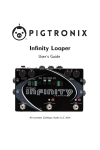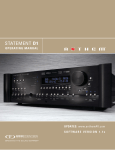Download D1 Review
Transcript
P R O D U C T REVIEW D1 “Possibly the best ” all around AV preamp on the market ... – AudioVideo Revolution CHRISTOPHER ZELL,Ph.D. There are a variety of corporate philosophies among audio component manufacturers, from the budget end with gobs of features and extras, usually at the expense of sonics, through those with bare bones features and somewhat utilitarian cosmetics, focusing on quality, sound and value. At the extreme opposite end of the spectrum are the manufacturers who design and offer components without cost as a primary concern. Anthem, which is part of Sonic Frontiers International under the Paradigm Group, has historically placed itself in an interesting position between these two philosophies. They have earned a reputation for excellent sonics at relatively affordable price points positioned well below the absolute high end. Typically, they have not reduced their feature set in the process and have gone one step further in their new Statement series of electronics. The Statement component line is designed to compete toe-to-toe with anything else on the market, regardless of price. In fact, Anthem welcomes direct comparisons. Far from the stratospheric price point that many flagship processors command today, the Statement components are slightly pricier than the still-offered standard Anthem line. The subject of this review is the new Statement D1 Preamplifier/ Processor/Tuner. DESCRIPTION Although the Statement D1 is built on the same platform as the proven, well-regarded AVM 20, this is where the similarity ends, according to Anthem. The D1 contains custom-designed circuit boards as well as the highest-quality active and passive components, including AKM® AK5394A analog-to-digital converters capable of up to 24-bit 192-kHz resolution. Processing is provided by dual Motorola® DSP 56367 engines, and all digital inputs are converted to 192 kHz by the D1’s own built-in stateof-the-art up-sampler. The Anthem D1 is an extremely versatile and sophisticated component that therefore warrants a lengthy description to represent the multitude of features and functions. Cosmetically, the D1 is very elegant; the black faceplate features gently curved wings on both sides, with a liberal sprinkling of buttons and controls. The overall look is somewhat reminiscent of the Anthem AVM 20 and AVM 30 home theater preamplifiers, but with a touch more class and grace. When powered, the numerous indicator LEDs and the large, informative main display centered on the front panel glow a wonderful blue. The display can be turned off, set to four different intensity levels D1 and briefly brightened after you make an adjustment, the amount of time variable between one and 15 seconds. Most of the functionality of the Anthem D1 is controllable via the front panel, which is laid out in a very logical fashion. Despite this, the controls are numerous and the adequately contrasted white labels too small by necessity to make this convenient for my aging eyes, unless the panel is well illuminated and in very close proximity. I am sure the locations of key buttons could be easily recalled after repeated use, but why bother when you can adjust everything from the listening seat with the supplied remote control? I found the Statement D1 Universal Learning Remote to be much better than average, with its logical button placement, differing button shapes and sizes and backlighting. As with many remotes, secondary button functions are not visible even when backlit, but in general, it was easy and intuitive to use. Since my home theater system’s electronics component complement changes more rapidly than I am willing to re-program any remote, I cannot comment on the D1 remote’s abilities as a universal controller, other than to say that it can have nine “personalities” according to the Anthem manual. “I can give no higher recommendation than to say that my system has never sounded better than with the Anthem Statement D1 at the reins.” As expected, the rear panel is quite full of inputs and outputs, starting with the IEC power cord connection at the lower left. The D1 has seven single-ended stereo analog inputs (selectable as direct or DSP), each with its own associated coaxial RCA digital audio, composite video and S-Video receptacles. Four sets of HDTV-compatible component video jacks are assignable to any input. As is usually the case, the D1 does not provide Onscreen Display (OSD) for the two sets of component video outputs, but it also does not perform any format translation between composite, S-Video and component video. I do not consider this a huge problem, but it is important to realize this rather than wonder why there is no video signal present at the composite output when only S-video and component connections are made from video sources. This happened to me and caused confusion for a few moments, but was quickly rectified by adding a single cable once I realized my error. In addition to the seven coaxial digital audio inputs, the Anthem has three optical (TOS) inputs and one balanced AES/EBU-XLR jack, all of which are assignable. Stereo audio, as well as composite and S-video outputs, are provided for Zone 2, Zone 3 and two full audio/video tape loops. Two coaxial outputs can provide digital audio from any source set to “digital” or “analog DSP,” with adjustable bit depths (16 and 24) and sample frequencies (44.1 kHz, 48 kHz, 88.2 kHz and 96 kHz). The two-channel analog inputs, the balanced XLR input and the six-channel single-ended input (primarily intended for DVD-Audio and multi-channel SACD players) can be set to bypass all of the D1’s digital stages or to include DSP processing, such as bass management, time alignment, surround modes and bass/treble controls. When the six-channel input is selected, the video signal from the DVD input is routed to the video outputs. Both balanced 2 XLR and single-ended RCA outputs are provided for 10 channels, with a default to a full 7.1 system, plus a second center channel and second subwoofer. The second subwoofer and center channel XLR outputs can be reconfigured as balanced outputs for Zone 2, which could come in handy to minimizing noise for longer runs often associated with auxiliary zones. “Cobham’s larger-than life drumset was very deep across the front stage … the image moving in a circle — rather than just back and forth between the three speakers … smooth presentation of piano … lusciously detailed bass … snappy percussion …” All of the control-related input/output is located near the right top portion of the rear panel. A bi-directional RS-232 port is provided for firmware upgrades, making the D1 upgrade friendly. Three powered Infrared (IR) receivers allow for remote control usage from other locations and a pair of IR emitters enables control of your source components from any location that has an IR repeater. Finally, any components that have trigger provisions can be automatically turned on and off with the D1 via three flexible relay triggers. Whew, that covers most of the D1, although I will not guarantee I have remembered everything, whether it is because of space constraints or unintentional omission. Later in the review, I will discuss details of the D1’s functionality and set-up, which clearly rivals almost anything on the market today. SET-UP When I acquire a new component, I am extremely impatient to get it in the system, and I find myself immediately checking it out and playing with it. Forget reading the details in the manual, let’s get it cranking. This is often easier said than done with something as complex as the Anthem D1. Fortunately, this is where the convenient “Quick Start” section near the front of the manual comes into play. You can set up a few sources and your amplifiers in a relatively short period of time with the aid of this section, particularly the schematic diagrams. Once the unit was roughly inserted into the system, I then read the manual to fine-tune and optimize the D1, while enjoying it all at the same time. Often this is the case, as I like to just watch a movie or concert video right off the bat after minimal optimization, satisfying my unhealthy need for instant gratification, all the while keeping my expectations relatively low and realistic during these initial stages. The entire set-up menu structure can be accessed via the OSD or the front panel, a welcome feature for those who would otherwise be forced to turn on their video display or projector every time an adjustment is desired. The OSD is not available on the component video outputs, but the user can individually select whether or not the composite and S-Video outputs receive it. The position of the OSD overlay (bottom, middle or top), the background color, and whether the Main and Zone 2 video outputs receive various adjustment updates are all configurable. The adjustable color is said to allow different monitors to synchronize D1 3 properly if the menus appear unstable. With my projector, the lower portion of the display flickered somewhat regardless of the background chosen, but I suspect that was an issue with the projector, not the D1. “… very transparent and capable of revealing detail even in subtle music … acoustic guitar and tambourine — were crisp and clean … strings smooth … breathy, soothing vocals floated above the guitar and occasional pick squeaks.” Even with features common to virtually all home theater preamps and receivers such as bass management, listener position and loudspeaker set-up, the Anthem D1 sets itself apart by virtue of its extra versatility and adjustability. For example, listening positions are adjustable to within 0.5 feet (or 0.2 meters), and loudspeaker calibration and main output levels in 0.5 dB increments (the unfortunately normal 1 dB increment is much too coarse, in my opinion). All crossover frequencies are adjustable in convenient 5-Hertz increments, and the cutoff point for the subwoofer and the high pass frequencies for the fronts, center, surrounds and rears are all completely independent. The Speaker Configuration Menu has the usual settings for speakers present (5.1, 7.1 etc.), size (small or large), and crossover frequency. But there are a few new twists incorporated in the Anthem D1, including special equalization settings for center channels placed in a wall unit, on a bookshelf or on top of a TV (with settings available for the width of the TV). I bypassed this equalization, since my current available center channel speakers are stand-mounted below a projection screen. Surround and rear speakers are selected according to their radiation patterns, either direct or dipole. Anthem claims that no delay is necessary for dipoles speakers since the sound is already delayed through room reflections. Any surround speakers specified as dipole will have their distance set automatically equal the greatest distance entered in the “listening position” menu, thereby ensuring they will have no delay. I’m not sure if I agree with this or not, since there is still significant direct localization heard from even dipoles. My reference surrounds are set as direct monopoles anyway, so I did not play with this feature extensively, nor did it concern me. Subwoofer hook-up is very flexible, starting with the selection of none, one, or two, and the option to receive low bass from all speakers, even those set to large. I have run into a few processors and receivers that have this “double bass” as the only option, which I do not think is proper. Having the option to augment all bass content is fine, but I don’t want it forced on me and, thankfully, Anthem has done it right. Throughout this evaluation, I never employed this added bass feature. A very useful room resonance filter with adjustable center frequency, filter depth and width is available to tame a prominent room response peak. I have discussed this issue in a couple of my recent subwoofer reviews, and I applaud Anthem for including this in their D1 processor. A variable level test tone sweep from 18 Hertz up to the crossover frequency facilitates finding these peaks, and it is also useful for optimizing the placement of subwoofer(s). I utilized both single and dual subwoofers over the last few months, and the filter came in very handy, especially in single subwoofer applications. Subwoofer options also include phase, polarity, peak level and THX boundary gain compensation. Two complete bass management configurations are allowed, referenced as “Cinema” and “Music.” The music configuration defaults to a copy of cinema, which is how I left it. After much finagling, I settled on a 60 Hz crossover for the left and right main speakers, 80 Hz for the surrounds, and either 80 or 100 Hz for the center channel as I fluctuated between single and dual subwoofers. After setting up the loudspeakers in my 7.1 system by entering the distances and setting the levels to within 0.5 dB according to my Radio Shack SPL meter, I moved on to source set-up. I won’t even attempt to explain all of the options here, since it would take much too long. Sources can be renamed, audio inputs can be specified as digital, analog pass-through or analog DSP, video synch-up delays can be set, video source assigned, subwoofer configuration chosen, and mode and THX preferences can be picked that will be applied when a source is selected or main power turned on. Anthem’s “last used” selection was most useful, since I tend to use a universal CD/DVD/DVDAudio/SACD player, and spin discs in groups of a particular type, making the most likely choice whatever was previously selected. Relative levels for each input can be chosen, which is useful for matching volume levels, or purposely lowering some, similar to what I chose with the FM/AM tuner to make it come on gracefully. “… acoustic guitars — were crisp and detailed … percussion parts jumped out with clarity and snap … I have never heard [this song] as dynamic as through the D1 … the drums sharp and visceral and the power of a live concert as realistically reproduced as I have heard in my system.” One option I used extensively, to great effect, was copying the surround speaker information to the rear channels. Often, I would temporarily lower the level of the rear speakers, and the end result was more spacious without being obtrusive. Speaking of temporary level adjustments, I consider remote control hot keys that provisionally change front, subwoofer, surround, and center speaker levels to be mandatory, while adjusting to specific DVD mixes, different DVD sources and increasing the center and lowering the subwoofer, especially for late-night listening. The D1 features six different timers similar to an alarm clock, two each for all three zones. At times, my home theater room doubles as a sleeping space, so I utilized the main zone timers for a gentle wake-up in the morning, and also to turn off at night after I had fallen asleep. Each timer can be set to function on weekdays, weekends or both, which is very convenient for nine-to-fivers that operate on different weekend schedules. Initially, I had a problem with occasional spurious noise bursts in the surround speaker outputs when a new digital stream was detected. This problem was readily solved by D1 downloading new firmware, and changing an initial signal mute delay parameter in the “Source Set-up.” Software updating is very simple with the D1, simply download the latest firmware from the Anthem Statement website, statement.anthemav.com, and connect your PC or laptop via a serial port to the D1. One word of caution might be in order: updating the firmware took a very long time, at least from my fairly new laptop. Until I disabled all screen and power saver options, the process was continually aborted before completion. I spent one scary night with a completely dead D1, but once I forced the laptop to be live at all times, the situation was quickly rectified. (After being brought to Anthem's attention, they will be adding a notice in the manual regarding disabling power saver during installation.) MUSIC After an initial period of casual listening and video viewing, I started my evaluation process with some two-channel listening. I find this an effective way of checking out the basic sonic character of a component without the confusion and added stimulus of additional loudspeakers and video. A few sessions with one of my favorite late-night CDs, Mazzy Starr’s So Tonight That I Might See (Capitol), made it clearly evident that the Anthem D1 was very transparent and capable of revealing detail even in subtle music such as this. The acoustic guitar and tambourine in “Five String Serenade” were crisp and clean through the D1, the strings smooth behind Starr’s gentle, almost emotionless vocals. In my favorite cut, “Into Dust,” Starr’s breathy, soothing vocals floated above the guitar and occasional pick squeaks. “Regardless of the format, multi-channel or stereo, the music flowing through the D1 was fabulous, a reflection of the source, the Anthem in no way a limiting factor.” I was ecstatic when I spotted Billy Cobham’s classic fusion album Spectrum (Atlantic Recording Corp.), released on DVD-Audio, with both multi-channel and stereo high-resolution audio available. I have been a huge Cobham fan since his days with Mahavishnu Orchestra, and the addition of former bandmate Jan Hammer on keyboards and a young Tommy Bolin on guitar makes this a can’t miss disc. Multi-channel music and systems can sound surprisingly unexciting, and in some ways less three-dimensional than two-channel, like a sphere of sound around you, but with little or no thickness to it. This was not true of the title cut, which features one of my favorite drum solos ever recorded. Despite the relatively non-aggressive use of surrounds, the presentation through the Anthem was not flat in the least. Cobham’s larger than life drum set was very deep across the front of the stage, the image moving in a circle around him rather than just back and forth between the three front speakers. The combination of the D1 and the high-resolution DVD-Audio source was a perfect match for recreating the sweetness, as well as the detail of what I assume the master tapes contain. This was especially apparent when focusing on Bolin’s guitar work, as well as Hammer’s piano. Closely microphoned piano is a very difficult test for systems, often sounding harsh, like fingernails on a blackboard, to me. The D1’s smooth presentation of piano breaks in “To the Women in my Life” and the lusciously detailed bass and snappy percussion created a satisfying contrast to the immediately preceding cut, “Stratus.” Cobham’s 4 ambitious assault was spectacular during “Snoopy” without hurting my ears or overpowering the back-and-forth play between Hammer and Bolin. Switching to the high-resolution two-channel version of this cut verified all of the above observations, with perhaps an increased front depth, although the soundstage of course collapsed to the front of the room. Regardless of the format, multi-channel or stereo, the music flowing through the D1 was fabulous, a reflection of the source, the Anthem in no way a limiting factor. “The more realistic and more dynamic it sounds, the more detail it extracts, the more I am pulled into the movie … spectacular with blockbuster films … the best I have heard them sound, including in the theater.” The Anthem D1 contains a very high-quality headphone preamplifier, designed with the Motorola® MC33078 operational amplifiers, and Wima MKS 2 metalized polyester film capacitors, renowned for minimizing high-frequency distortion. The combination of a dedicated, fully discrete output stage and ±15 Volts DC power rails enables wide volume capability, and the ability to handle both high and low impedance headphones alike. I verified this to my satisfaction by utilizing a wide variety of headphones from Grado, Sennheiser and AKG, all of which sounded open, dynamic and effortless. The headphone amplifier can operate with or without the main speakers on, and has separate volume, bass and treble controls. Anthem also incorporates a very competent, versatile AM FM tuner section, with 18 FM and six AM presets. This did an excellent job pulling in my favorite local radio stations, as well as some not-so-local ones, with exemplary rejection and fidelity, and I enjoyed listening to them as background throughout the day. MOVIES Much to my surprise – if you would have told me this a year ago, I would have said you were crazy – I spend as much time (actually, often more) watching movies on my home theater as I do listening to music. I appreciated my D1-based system with music of all sorts, but despite my increased viewing of movies, it is becoming increasingly difficult to write about what I hear in soundtracks. The more realistic and more dynamic it sounds, the more detail it extracts, the more I am pulled into the movie and the less I think about my home theater system and/or the particular component I am evaluating. “… exemplary performance with action sequences … it was often the more subtle soundtracks that enforced my appreciation of its capabilities … stunning detail, threedimensional and exciting.” Not surprisingly, the D1 was spectacular with blockbuster films. Over the last month, I watched (again) the entire Lord of the Rings trilogy (New Line Home Entertainment), including the extended versions of The Fellowship of the Ring and The Two Towers, of course, with my kids, and it was the best I have D1 5 heard them sound, including in the theater. I did not think about the sound during the movie, it just fit right in and melded with the video: intelligible, subtle and shocking when a mumakil (giant elephant) stomped through the room. I feared my six-year-old would have nightmares for months after witnessing and hearing the terrifying spider Shelob slither after Frodo, the D1 effectively placing us in the middle of her lair, but fortunately she is braver than I, who would have been permanently warped had I experienced that at her age. “… designed to compete toe-to-toe with anything else on the market, regardless of price … extremely versatile and sophisticated … very elegant … functionality and set-up — clearly rivals almost anything on the market today.” Despite the D1’s exemplary performance with action sequences, it was often the more subtle soundtracks that enforced my appreciation of its capabilities. One unlikely example was The Falcon and the Snowman (MGM/UA Home Entertainment). This DVD is an old two-channel mix, not very exciting sonically, both in quality and because of the absence of crashes and explosions (this is not a blast-’em-up film). But when the occasional cut in Pat Metheny’s wonderful soundtrack escalated, my system responded with stunning detail, three-dimensional and exciting. The title song featuring David Bowie on vocals put a huge smile on my face, snapping my ears to attention. Despite being somewhat long in the tooth as far as concert videos, the Eagles’ Hell Freezes Over (Image Entertainment) still gets a lot of playing time, many times as a demo for music enthusiasts who visit my home. The DTS soundtrack still sounds excellent to my ears, never more so than through the Anthem D1. The acoustic guitars throughout the unplugged, relatively mellow opening section of the concert were crisp and detailed and the percussion parts jumped out with clarity and snap, particularly in cuts like “Love Will Keep Us Alive.” “Get Over It,” a song which I was never overly fond of before watching this video, has become a favorite of my friends and I when we are in the mood to rock. I have never heard it as dynamic as through the D1, with the drums sharp and visceral and the power of a live concert as realistically reproduced as I have heard in my system. DOWNSIDE I have very little to complain about concerning the Anthem D1, but there are a few minor things that come to mind. Although clearly open to personal preference, I did not care for the exponential sensitivity of the remote volume control. Beyond changing a dB or so, the level jumped past where I ultimately wanted it, somewhat offsetting the very welcome granularity of 0.5 dB steps in level. A lack of DVI and or HDMI inputs is also a shortcoming for those who have (or see the potential for) more than one HD source that needs to be connected digitally. You can run HD sources through the D1 via component video, so if you had, for example, an HD TiVo and a D-VHS deck, you could run the HD TiVo to your monitor digitally via HDMI and then run your D-VHS to your D1. In the future, you might expect to be able to seamlessly switch HDMI and or DVI in your preamp and there are even rumors that such a card may be coming as an add-on for the D1, yet nothing official has been announced. The lack of translation between video input formats can be inconvenient, although this is not a very serious concern. In comparison to the Mark Levinson No. 40 AV preamp priced at $30,000, this is a downside. At a fraction of that price, consumers should understand why there is no video transcoding in the D1. Finally, while I do feel that the D1 is a top-flight performer, you could argue that the law of diminishing returns is approaching even within Anthem’s own line, specifically with the AVM 30. I did not have an AVM 30 for direct comparison, but based on my past experience with its predecessor, the AVM 20, it is a capable performer and flexible unit that may well suffice in systems with anything less than reference quality surrounding electronics and loudspeakers. CONCLUSION I am sure it is obvious if you have read through to this point that I am quite enamored with the Anthem Statement D1 Preamplifier/Processor/Tuner. Although I have spent considerable time with many high-end contenders such as the Lexicon MC-12 and Meridian preamp/processors, I did not have any of them handy for comparisons. Since I strongly believe that sonic “memory” over previous events and components is at best misleading, and at worst totally incorrect, I will refrain from direct comparisons between the Anthem and any of its esteemed competition. Additionally, while I do think that short term, direct A-B comparisons are valid, I also maintain that long-term impressions of a product are just as important, if not more so. In this situation, I am applying my judgment based on my impressions of my home theater system during the time that the Anthem D1 was at the controls. Am I playing more music, reviving old music I have not thought about for ages and are movies drawing me in? With the Anthem D1, the answer to these questions is a simple yes – I have played the daylights out of my system these last few months, alternating between listening to little details and harmonies, or just sitting back with my eyes closed and smiling as I re-embrace old favorites. I can give no higher recommendation than to say that my system has never sounded better than with the Anthem Statement D1 at the reins.














